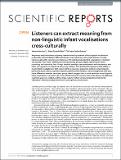Files in this item
Listeners can extract meaning from non-linguistic infant vocalisations cross-culturally
Item metadata
| dc.contributor.author | Kersken, Verena | |
| dc.contributor.author | Zuberbühler, Klaus | |
| dc.contributor.author | Gomez, Juan-Carlos | |
| dc.date.accessioned | 2017-01-25T16:30:09Z | |
| dc.date.available | 2017-01-25T16:30:09Z | |
| dc.date.issued | 2017-01-25 | |
| dc.identifier | 248669616 | |
| dc.identifier | e353862e-d536-4e15-8fb4-ce82dedf22b6 | |
| dc.identifier | 85010777978 | |
| dc.identifier | 000392661200001 | |
| dc.identifier.citation | Kersken , V , Zuberbühler , K & Gomez , J-C 2017 , ' Listeners can extract meaning from non-linguistic infant vocalisations cross-culturally ' , Scientific Reports , vol. 7 , 41016 . https://doi.org/10.1038/srep41016 | en |
| dc.identifier.issn | 2045-2322 | |
| dc.identifier.other | ORCID: /0000-0001-8378-088X/work/64360659 | |
| dc.identifier.other | ORCID: /0000-0002-0218-9834/work/64361095 | |
| dc.identifier.uri | https://hdl.handle.net/10023/10174 | |
| dc.description | Study funded by Leverhulme Trust (F/00268/AP) and European Research Council (PRILANG 283871) Grants. | en |
| dc.description.abstract | We present empirical evidence showing that the acoustic properties of non-linguistic vocalisations produced by human infants in different cultures can be used cross-culturally by listeners to make inferences about the infant’s current behaviour. We recorded natural infant vocalisations in Scotland and Uganda in five social contexts; declarative pointing, giving an object, requesting an action, protesting, and requesting food. Using a playback paradigm, we tested parents and non-parents, who either had regular or no experience with young children, from Scotland and Uganda in their ability to match infant vocalisations of both cultures to their respective production contexts. All participants performed above chance, regardless of prior experience with infants or cultural background, with only minor differences between participant groups. Results suggest that acoustic variations in non-linguistic infant vocalisations transmit broad classes of information to listeners, even in the absence of additional cues from gesture or context, and that these cues may reflect universal properties similar to the ‘referential’ information discovered in non-human primate vocalisations. | |
| dc.format.extent | 7 | |
| dc.format.extent | 320465 | |
| dc.language.iso | eng | |
| dc.relation.ispartof | Scientific Reports | en |
| dc.subject | BF Psychology | en |
| dc.subject | NDAS | en |
| dc.subject | BDC | en |
| dc.subject.lcc | BF | en |
| dc.title | Listeners can extract meaning from non-linguistic infant vocalisations cross-culturally | en |
| dc.type | Journal article | en |
| dc.contributor.sponsor | The Leverhulme Trust | en |
| dc.contributor.institution | University of St Andrews. School of Psychology and Neuroscience | en |
| dc.contributor.institution | University of St Andrews. Institute of Behavioural and Neural Sciences | en |
| dc.contributor.institution | University of St Andrews. Centre for Social Learning & Cognitive Evolution | en |
| dc.identifier.doi | https://doi.org/10.1038/srep41016 | |
| dc.description.status | Peer reviewed | en |
| dc.identifier.grantnumber | F/00 268/AP | en |
This item appears in the following Collection(s)
Items in the St Andrews Research Repository are protected by copyright, with all rights reserved, unless otherwise indicated.

